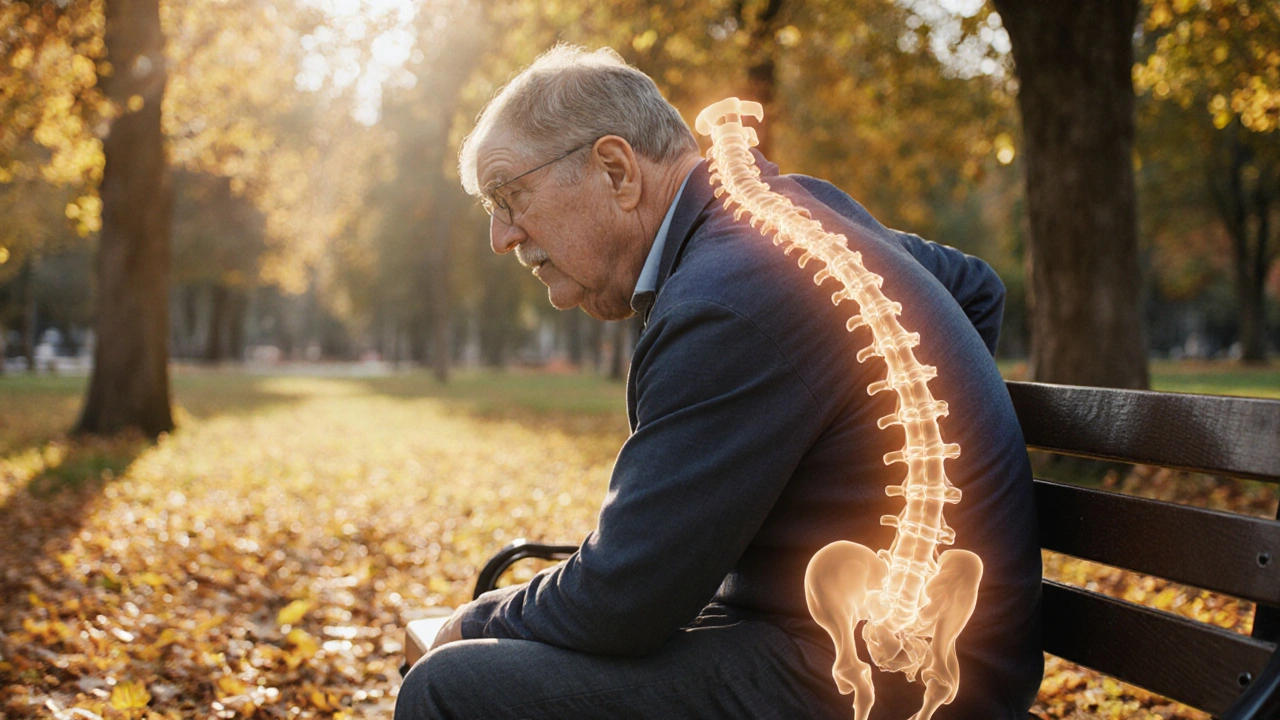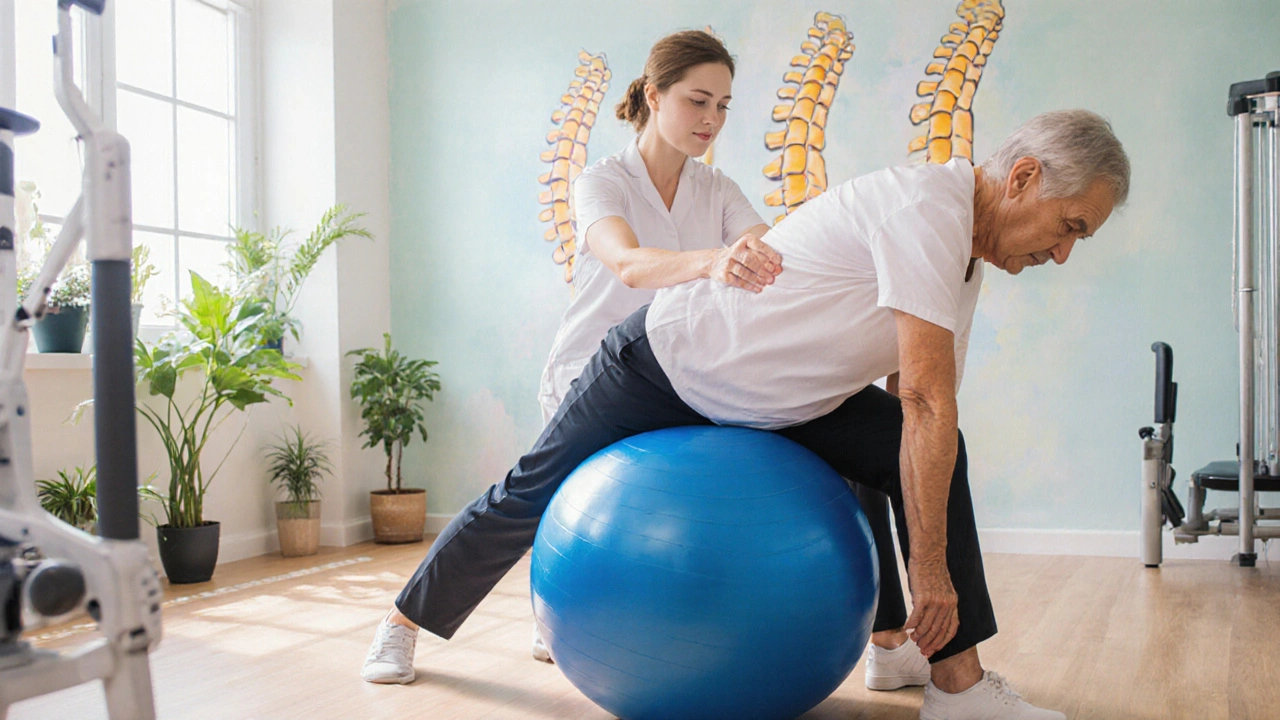Spinal Osteoarthritis: Recognizing Symptoms, Effective Treatments, and Proven Prevention Tips
 Sep, 29 2025
Sep, 29 2025
Spinal Osteoarthritis Risk Calculator
This tool estimates your risk of developing spinal osteoarthritis based on age, weight, activity level, and symptom presence.
When the tiny joints of your back start to wear down, the pain can feel like a constant reminder that something's off. Spinal osteoarthritis is a degenerative condition where the cartilage that cushions the bones of the spine breaks down, leading to inflammation, stiffness, and the all‑too‑familiar ache that makes everyday tasks a grind.
TL;DR
- Common signs include low‑back pain, stiffness, and reduced mobility.
- Diagnosis relies on physical exam plus imaging like X‑rays or MRI.
- First‑line treatment is often NSAIDs and targeted physical therapy.
- Weight control, regular low‑impact exercise, and good ergonomics can slow progression.
- Seek a specialist if pain interferes with sleep or daily activities.
What Are the Warning Signs?
Spinal osteoarthritis doesn’t announce itself with fireworks; it creeps in gradually. Typical symptoms are:
- Persistent back pain that worsens after sitting or standing for long periods.
- Morning stiffness that eases after a short walk.
- Reduced range of motion, especially when trying to bend or twist.
- Occasional radiating pain into the hips or shoulders, depending on the affected spinal segment.
- Feeling of grinding or clicking when moving-clinicians call this crepitus.
If you notice any of these patterns for more than a few weeks, it’s time to get checked out.
How Do Doctors Confirm the Diagnosis?
Physical assessment is the first step. A clinician will test your flexibility, check for tender points, and listen for abnormal joint sounds. Imaging then paints a clearer picture.
- X‑ray: Shows narrowing of the joint space, bone spurs, and changes in the shape of the vertebrae.
- MRI: Highlights soft‑tissue changes, such as inflamed cartilage and disc degeneration, giving a more detailed view of the disease’s severity.
Blood tests aren’t usually diagnostic for osteoarthritis but can rule out inflammatory arthritis that requires different treatment.

Treatment Options: What Actually Works?
Management is a mix of symptom relief, slowing the wear‑and‑tear, and maintaining function. Below is a quick rundown of the most common approaches.
- Medication
- NSAIDs (e.g., ibuprofen, naproxen) reduce pain and inflammation. They’re often the first line, but long‑term use can irritate the stomach lining.
- Corticosteroid injections into the facet joint provide short‑term relief but aren’t a permanent fix.
- Physical Therapy
- Physical therapy focuses on core strengthening, flexibility, and posture training. A tailored program can improve pain scores by up to 40% in clinical studies.
- Exercise & Activity
- Low‑impact aerobic exercise (walking, swimming, cycling) keeps joints lubricated without overloading them.
- Regular stretching reduces stiffness and improves range of motion.
- Weight Management
- Carrying extra pounds adds stress to the lumbar spine; shedding even 5‑10% of body weight can noticeably lower pain.
- Surgical Options
- In severe cases, a spinal fusion or facet joint replacement may be considered, but surgery is typically a last resort after conservative measures fail.
| Modality | Typical Effectiveness | Key Risks | Usual Duration |
|---|---|---|---|
| NSAIDs | Moderate pain relief (30‑50%) | GI irritation, cardiovascular strain | Short‑term, as needed |
| Physical Therapy | High functional improvement (40‑60%) | Minimal; temporary soreness | 6‑12 weeks, ongoing maintenance |
| Weight Management | Variable; 5‑10% weight loss = 10‑20% pain reduction | None when done healthily | Long‑term lifestyle change |
| Surgical Fusion | High pain relief (70‑80%) | Infection, nerve injury, reduced spinal flexibility | Months of recovery |
Preventing the Progression
While you can’t reverse cartilage loss completely, you can definitely slow it down.
- Maintain a healthy weight. Even modest weight loss relieves pressure on the lumbar vertebrae.
- Stay active with low‑impact exercise like brisk walking, swimming, or yoga. Aim for at least 150 minutes per week.
- Practice good posture-whether you’re at a desk, in a car, or lifting a grocery bag. Keep hips and shoulders aligned; consider ergonomic chairs or standing desks.
- Strengthen the core. A strong abdomen acts as a natural brace for the spine, reducing stress on facet joints.
- Limit repetitive bending or heavy lifting. If your job requires it, use proper lifting techniques or mechanical aids.
Nutrition also plays a subtle role. A diet rich in omega‑3 fatty acids, antioxidants, and vitamin D supports joint health, though supplements should complement-not replace-real food.
Living with Spinal Osteoarthritis
Managing flare‑ups is part of daily life. Here are some quick tactics:
- Apply heat before activity to loosen stiff joints; use ice afterward if swelling appears.
- Break up long periods of sitting with short walks or gentle stretches every 30 minutes.
- Use a lumbar roll or pillow when sleeping to maintain the natural curve of the spine.
- Consider over‑the‑counter topical analgesics for spot‑treatment without systemic side effects.
Everyone’s threshold is different. Pay attention to what triggers your pain and adjust accordingly.
When to Call a Professional
If any of the following occurs, schedule an appointment promptly:
- Pain that wakes you up at night or worsens despite OTC meds.
- Numbness, tingling, or weakness in the legs-signs of nerve involvement.
- Sudden loss of bladder or bowel control, which could indicate a serious spinal emergency.
- Persistent pain that limits daily activities for more than a few weeks.
Early intervention improves outcomes and may keep you out of the operating room.

Frequently Asked Questions
Is spinal osteoarthritis the same as a slipped disc?
No. Osteoarthritis is a wear‑and‑tear of the joint cartilage, while a slipped disc (herniated disc) involves the inner gel of a disc pushing out through its outer layer. Both can cause back pain, but they have different underlying mechanisms and treatments.
Can diet really affect spinal osteoarthritis?
A balanced diet rich in anti‑inflammatory foods (fish, nuts, berries) may help reduce overall joint inflammation. While diet alone won’t cure the condition, it supports weight control and provides nutrients that protect cartilage.
How long should I stay on NSAIDs?
Use the lowest effective dose for the shortest period needed to control pain. Discuss long‑term plans with your doctor, especially if you have heart, kidney, or stomach issues.
Is surgery ever necessary?
Surgery is reserved for cases where conservative therapy fails and quality of life is severely impacted. Options include spinal fusion or facet joint replacement, but they come with significant recovery time and risks.
What everyday habits can worsen spinal osteoarthritis?
Prolonged sitting, heavy lifting without proper technique, smoking (which impairs blood flow to cartilage), and a sedentary lifestyle can all accelerate joint degeneration.
luemba leonardo brás kali
September 29, 2025 AT 03:18Spinal osteoarthritis often presents with morning stiffness lasting over 30 minutes, persistent pain that worsens with activity, reduced range of motion, and occasional grinding sensations. These symptoms are typically progressive and can limit daily tasks. Age and BMI are major risk factors, as highlighted by the calculator. Maintaining a healthy weight and staying active can mitigate some of the mechanical stress on the vertebrae. Early diagnosis and physical therapy are essential to preserve function.
Corey McGhie
October 4, 2025 AT 08:18Wow, because nothing screams "fun" like a risk calculator for your spine, right?
But hey, if you’re already scrolling through it, at least you’re thinking about your health.
I love how it forces you to confront the brutal truth that a sedentary lifestyle is basically an invitation for OA.
So grab those dumbbells, or at least walk to the fridge more often.
Remember, pain isn’t a badge of honor - it’s a reminder to move.
Keep crushing those excuses, and your back will thank you later.
Ajayi samson
October 9, 2025 AT 13:18This piece is just surface‑level fluff. The risk model ignores genetics, which is a massive oversight. Also, the UI looks like a 90’s web page, not a medical tool. If you’re serious about osteoarthritis, consult a specialist instead of trusting this gimmick.
Lief Larson
October 14, 2025 AT 18:18Spinal OA is real it hurts and it limits you the calculator is a start but you need real doctors for proper help
Julia Grace
October 19, 2025 AT 23:18Man, dealing with spinal osteoarthritis can feel like your back's stuck in a rusty hinge. First off, those morning stiffness episodes over half an hour are basically your spine yelling, “Wake up, I'm tired!” If you notice a nagging ache that ramps up when you hike up stairs, that's a red flag you shouldn't ignore. I’ve seen folks try to push through the pain and end up looking like a pretzel after a yoga class gone wrong. Keeping an eye on your BMI is crucial because extra pounds slap extra pressure on those vertebrae. Speaking of pressure, sedentary folks are practically feeding a slow‑burning fire under their spinal joints. A great antidote is regular low‑impact cardio-think brisk walks, swimming, or even dancing in your living room. Strength training for the core and back muscles also builds a supportive corset that eases joint strain. Don't forget flexibility work; a gentle stretch routine can keep that range of motion from shrinking. If you're already feeling clicking or grinding, that's your body's SOS signal to get evaluated. Many physiotherapists can teach you targeted exercises that reduce those annoying noises. Medications may help the pain but they won’t fix the underlying wear‑and‑tear, so use them wisely. And yeah, supplements like glucosamine have mixed reviews, so talk to a doc before loading up. In the long run, a balanced diet rich in anti‑inflammatory foods-berries, leafy greens, omega‑3s-can support joint health. Bottom line: stay active, keep the weight in check, and listen to your spine before it starts screaming louder.
Sadie Bell
October 25, 2025 AT 04:18Get moving today, your spine will thank you! Even a quick 10‑minute walk can make a difference.
kristine ayroso
October 30, 2025 AT 09:18Yo, if you think sitting on a couch all day won’t mess up your back, you’re dead wrong.
Those lazy habits pile up stress on the spinal discs like junk mail in your inbox.
Grab a dumbbell, do some rows, and show those vertebrae who’s boss.
Don’t be that person who complains about pain but never lifts a finger to change.
Consistency beats intensity every time, so set a schedule and stick to it.
Trust me, future you will be glad you stopped being a couch potato.
Dylan Hilton
November 4, 2025 AT 14:18The risk calculator is a handy way to visualize how age, weight, and activity level interact.
By entering your numbers, you can see whether you fall into low, moderate, or high risk.
This information empowers you to make lifestyle adjustments before symptoms worsen.
For instance, reducing BMI by a few points can lower your score significantly.
Likewise, swapping sedentary evenings for brisk walks adds valuable points.
Regularly revisiting the tool can track your progress over time.
Christian Andrabado
November 9, 2025 AT 19:18This article is a complete waste of time.
Chidi Anslem
November 15, 2025 AT 00:18Understanding spinal osteoarthritis goes beyond mere symptom lists; it invites us to consider the whole person.
The interplay of genetics, environment, and daily habits shapes how the disease manifests.
While calculators provide a snapshot, they cannot capture the nuanced reality of each individual.
It is essential to pair such tools with professional medical guidance.
Moreover, adopting a holistic approach-mindful movement, balanced nutrition, and stress management-can alter the disease trajectory.
Philosophy reminds us that prevention is an act of respect for our own bodies.
In that spirit, we should view each choice as a step toward preserving flexibility and comfort.
Ultimately, the goal is not just to predict risk but to cultivate resilience.